Samarth Bharadwaj
Adaptive Discounting of Implicit Language Models in RNN-Transducers
Feb 21, 2022
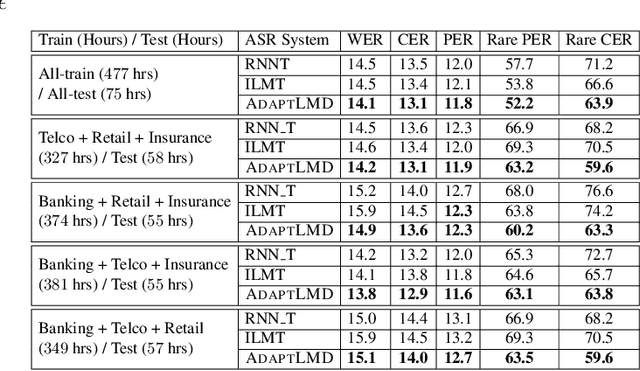
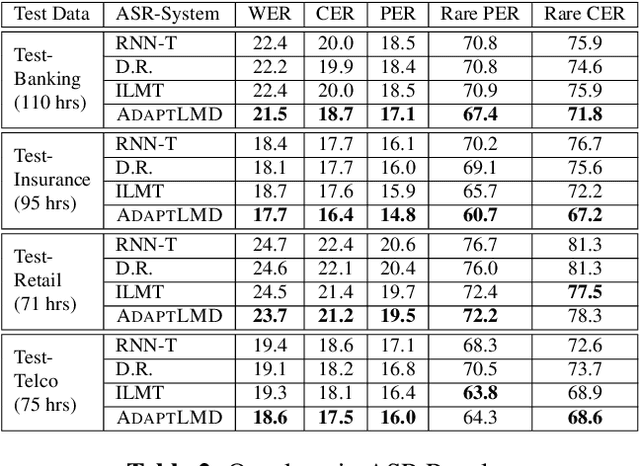
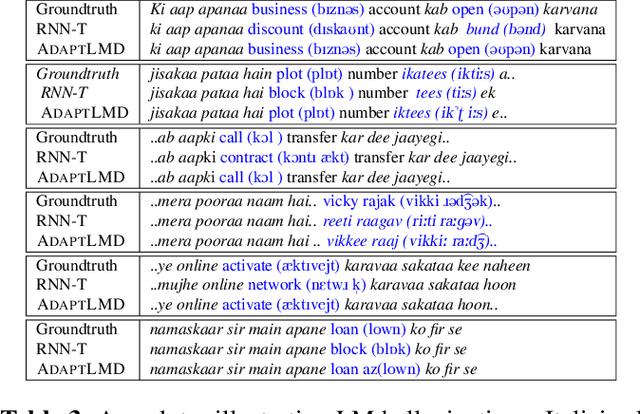
Abstract:RNN-Transducer (RNN-T) models have become synonymous with streaming end-to-end ASR systems. While they perform competitively on a number of evaluation categories, rare words pose a serious challenge to RNN-T models. One main reason for the degradation in performance on rare words is that the language model (LM) internal to RNN-Ts can become overconfident and lead to hallucinated predictions that are acoustically inconsistent with the underlying speech. To address this issue, we propose a lightweight adaptive LM discounting technique AdaptLMD, that can be used with any RNN-T architecture without requiring any external resources or additional parameters. AdaptLMD uses a two-pronged approach: 1) Randomly mask the prediction network output to encourage the RNN-T to not be overly reliant on it's outputs. 2) Dynamically choose when to discount the implicit LM (ILM) based on rarity of recently predicted tokens and divergence between ILM and implicit acoustic model (IAM) scores. Comparing AdaptLMD to a competitive RNN-T baseline, we obtain up to 4% and 14% relative reductions in overall WER and rare word PER, respectively, on a conversational, code-mixed Hindi-English ASR task.
Multi-Instance Training for Question Answering Across Table and Linked Text
Dec 14, 2021



Abstract:Answering natural language questions using information from tables (TableQA) is of considerable recent interest. In many applications, tables occur not in isolation, but embedded in, or linked to unstructured text. Often, a question is best answered by matching its parts to either table cell contents or unstructured text spans, and extracting answers from either source. This leads to a new space of TextTableQA problems that was introduced by the HybridQA dataset. Existing adaptations of table representation to transformer-based reading comprehension (RC) architectures fail to tackle the diverse modalities of the two representations through a single system. Training such systems is further challenged by the need for distant supervision. To reduce cognitive burden, training instances usually include just the question and answer, the latter matching multiple table rows and text passages. This leads to a noisy multi-instance training regime involving not only rows of the table, but also spans of linked text. We respond to these challenges by proposing MITQA, a new TextTableQA system that explicitly models the different but closely-related probability spaces of table row selection and text span selection. Our experiments indicate the superiority of our approach compared to recent baselines. The proposed method is currently at the top of the HybridQA leaderboard with a held out test set, achieving 21 % absolute improvement on both EM and F1 scores over previous published results.
Role of Language Relatedness in Multilingual Fine-tuning of Language Models: A Case Study in Indo-Aryan Languages
Sep 22, 2021
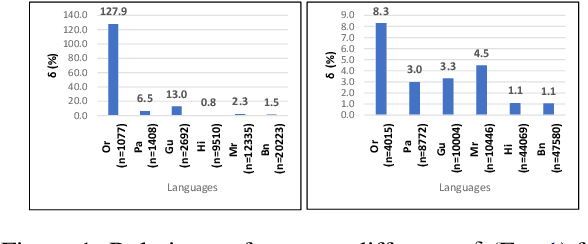

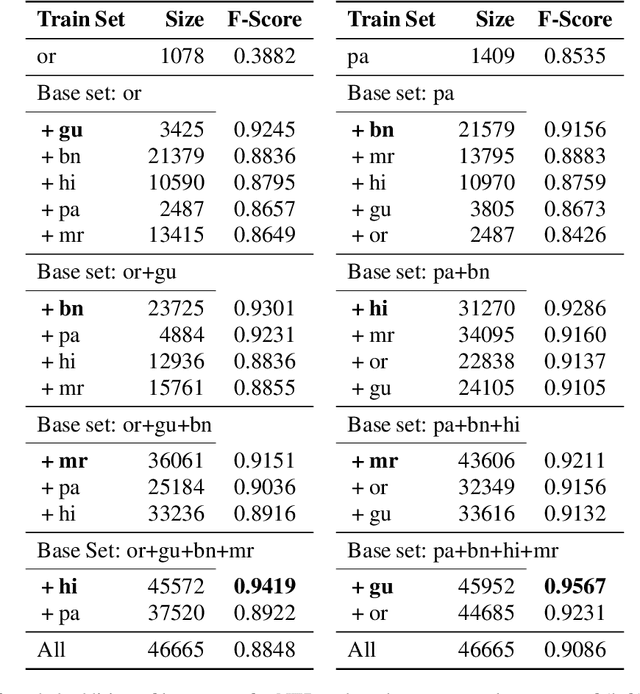
Abstract:We explore the impact of leveraging the relatedness of languages that belong to the same family in NLP models using multilingual fine-tuning. We hypothesize and validate that multilingual fine-tuning of pre-trained language models can yield better performance on downstream NLP applications, compared to models fine-tuned on individual languages. A first of its kind detailed study is presented to track performance change as languages are added to a base language in a graded and greedy (in the sense of best boost of performance) manner; which reveals that careful selection of subset of related languages can significantly improve performance than utilizing all related languages. The Indo-Aryan (IA) language family is chosen for the study, the exact languages being Bengali, Gujarati, Hindi, Marathi, Oriya, Punjabi and Urdu. The script barrier is crossed by simple rule-based transliteration of the text of all languages to Devanagari. Experiments are performed on mBERT, IndicBERT, MuRIL and two RoBERTa-based LMs, the last two being pre-trained by us. Low resource languages, such as Oriya and Punjabi, are found to be the largest beneficiaries of multilingual fine-tuning. Textual Entailment, Entity Classification, Section Title Prediction, tasks of IndicGLUE and POS tagging form our test bed. Compared to monolingual fine tuning we get relative performance improvement of up to 150% in the downstream tasks. The surprise take-away is that for any language there is a particular combination of other languages which yields the best performance, and any additional language is in fact detrimental.
Topic Transferable Table Question Answering
Sep 15, 2021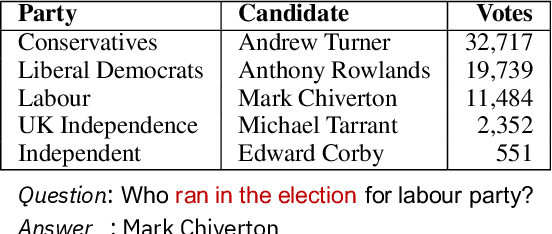
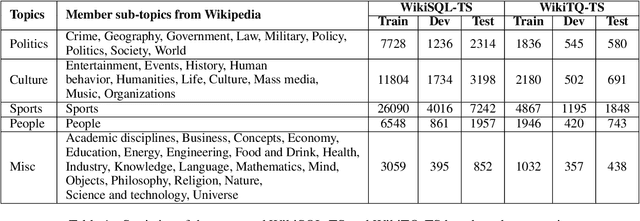
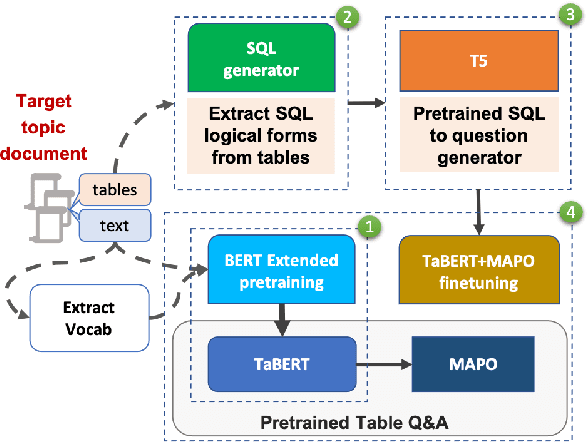
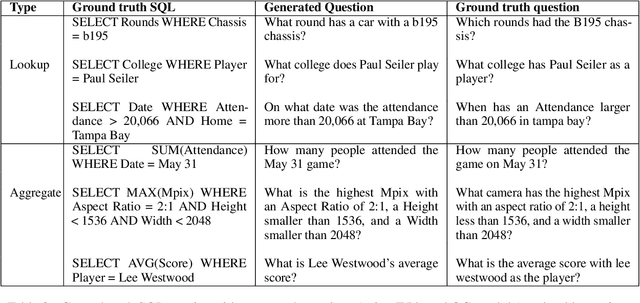
Abstract:Weakly-supervised table question-answering(TableQA) models have achieved state-of-art performance by using pre-trained BERT transformer to jointly encoding a question and a table to produce structured query for the question. However, in practical settings TableQA systems are deployed over table corpora having topic and word distributions quite distinct from BERT's pretraining corpus. In this work we simulate the practical topic shift scenario by designing novel challenge benchmarks WikiSQL-TS and WikiTQ-TS, consisting of train-dev-test splits in five distinct topic groups, based on the popular WikiSQL and WikiTableQuestions datasets. We empirically show that, despite pre-training on large open-domain text, performance of models degrades significantly when they are evaluated on unseen topics. In response, we propose T3QA (Topic Transferable Table Question Answering) a pragmatic adaptation framework for TableQA comprising of: (1) topic-specific vocabulary injection into BERT, (2) a novel text-to-text transformer generator (such as T5, GPT2) based natural language question generation pipeline focused on generating topic specific training data, and (3) a logical form reranker. We show that T3QA provides a reasonably good baseline for our topic shift benchmarks. We believe our topic split benchmarks will lead to robust TableQA solutions that are better suited for practical deployment.
Representation based meta-learning for few-shot spoken intent recognition
Jun 29, 2021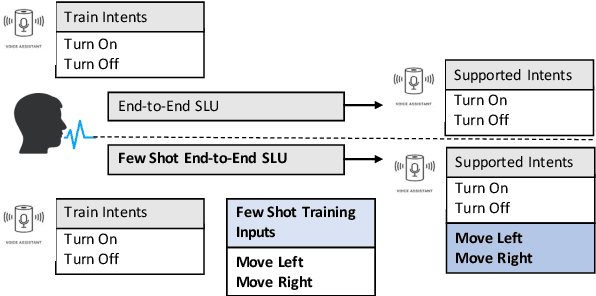

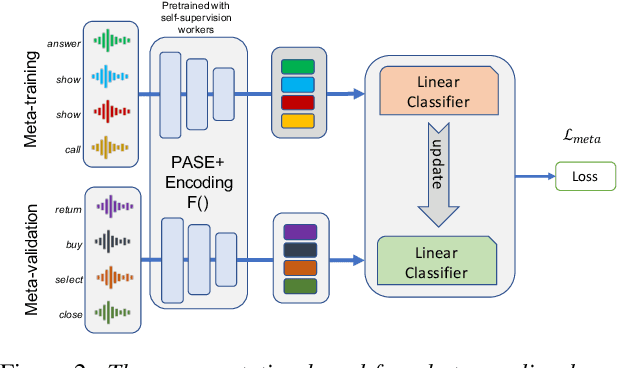

Abstract:Spoken intent detection has become a popular approach to interface with various smart devices with ease. However, such systems are limited to the preset list of intents-terms or commands, which restricts the quick customization of personal devices to new intents. This paper presents a few-shot spoken intent classification approach with task-agnostic representations via meta-learning paradigm. Specifically, we leverage the popular representation-based meta-learning learning to build a task-agnostic representation of utterances, that then use a linear classifier for prediction. We evaluate three such approaches on our novel experimental protocol developed on two popular spoken intent classification datasets: Google Commands and the Fluent Speech Commands dataset. For a 5-shot (1-shot) classification of novel classes, the proposed framework provides an average classification accuracy of 88.6% (76.3%) on the Google Commands dataset, and 78.5% (64.2%) on the Fluent Speech Commands dataset. The performance is comparable to traditionally supervised classification models with abundant training samples.
AIT-QA: Question Answering Dataset over Complex Tables in the Airline Industry
Jun 24, 2021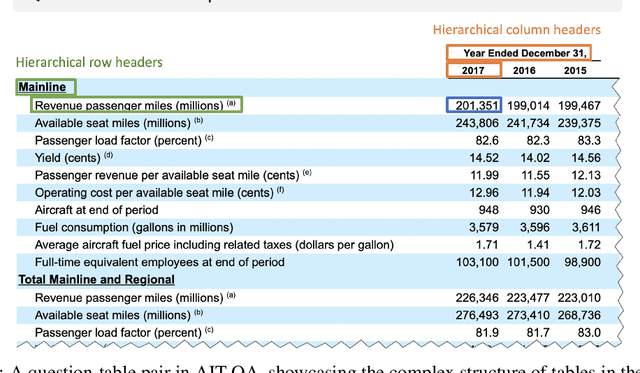

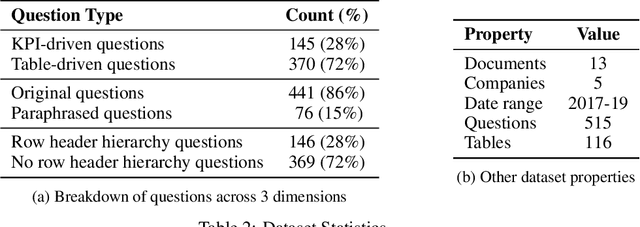

Abstract:Recent advances in transformers have enabled Table Question Answering (Table QA) systems to achieve high accuracy and SOTA results on open domain datasets like WikiTableQuestions and WikiSQL. Such transformers are frequently pre-trained on open-domain content such as Wikipedia, where they effectively encode questions and corresponding tables from Wikipedia as seen in Table QA dataset. However, web tables in Wikipedia are notably flat in their layout, with the first row as the sole column header. The layout lends to a relational view of tables where each row is a tuple. Whereas, tables in domain-specific business or scientific documents often have a much more complex layout, including hierarchical row and column headers, in addition to having specialized vocabulary terms from that domain. To address this problem, we introduce the domain-specific Table QA dataset AIT-QA (Airline Industry Table QA). The dataset consists of 515 questions authored by human annotators on 116 tables extracted from public U.S. SEC filings (publicly available at: https://www.sec.gov/edgar.shtml) of major airline companies for the fiscal years 2017-2019. We also provide annotations pertaining to the nature of questions, marking those that require hierarchical headers, domain-specific terminology, and paraphrased forms. Our zero-shot baseline evaluation of three transformer-based SOTA Table QA methods - TaPAS (end-to-end), TaBERT (semantic parsing-based), and RCI (row-column encoding-based) - clearly exposes the limitation of these methods in this practical setting, with the best accuracy at just 51.8\% (RCI). We also present pragmatic table preprocessing steps used to pivot and project these complex tables into a layout suitable for the SOTA Table QA models.
Capturing Row and Column Semantics in Transformer Based Question Answering over Tables
Apr 26, 2021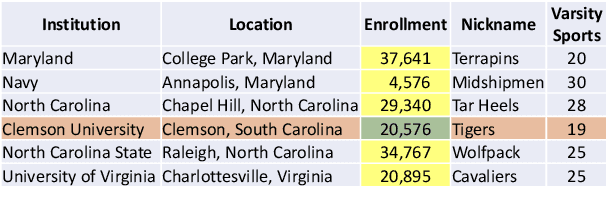
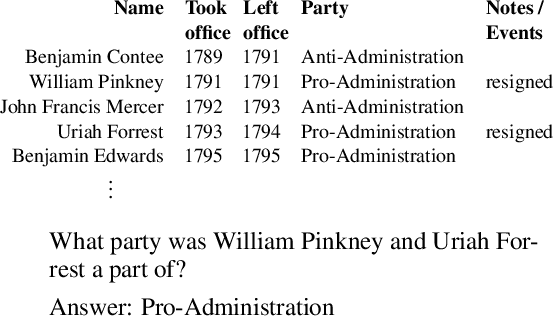
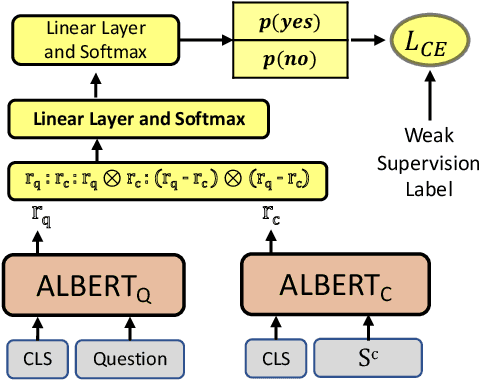

Abstract:Transformer based architectures are recently used for the task of answering questions over tables. In order to improve the accuracy on this task, specialized pre-training techniques have been developed and applied on millions of open-domain web tables. In this paper, we propose two novel approaches demonstrating that one can achieve superior performance on table QA task without even using any of these specialized pre-training techniques. The first model, called RCI interaction, leverages a transformer based architecture that independently classifies rows and columns to identify relevant cells. While this model yields extremely high accuracy at finding cell values on recent benchmarks, a second model we propose, called RCI representation, provides a significant efficiency advantage for online QA systems over tables by materializing embeddings for existing tables. Experiments on recent benchmarks prove that the proposed methods can effectively locate cell values on tables (up to ~98% Hit@1 accuracy on WikiSQL lookup questions). Also, the interaction model outperforms the state-of-the-art transformer based approaches, pre-trained on very large table corpora (TAPAS and TaBERT), achieving ~3.4% and ~18.86% additional precision improvement on the standard WikiSQL benchmark.
Multilingual and code-switching ASR challenges for low resource Indian languages
Apr 01, 2021
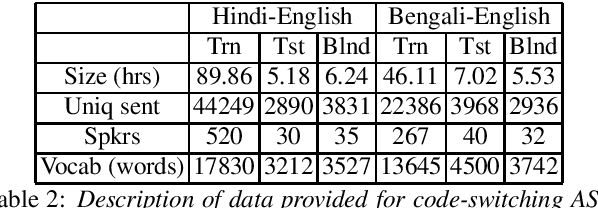

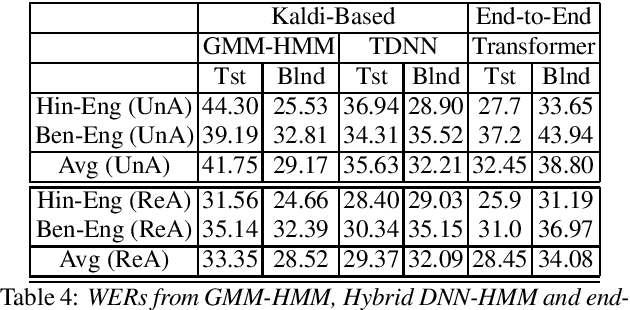
Abstract:Recently, there is increasing interest in multilingual automatic speech recognition (ASR) where a speech recognition system caters to multiple low resource languages by taking advantage of low amounts of labeled corpora in multiple languages. With multilingualism becoming common in today's world, there has been increasing interest in code-switching ASR as well. In code-switching, multiple languages are freely interchanged within a single sentence or between sentences. The success of low-resource multilingual and code-switching ASR often depends on the variety of languages in terms of their acoustics, linguistic characteristics as well as the amount of data available and how these are carefully considered in building the ASR system. In this challenge, we would like to focus on building multilingual and code-switching ASR systems through two different subtasks related to a total of seven Indian languages, namely Hindi, Marathi, Odia, Tamil, Telugu, Gujarati and Bengali. For this purpose, we provide a total of ~600 hours of transcribed speech data, comprising train and test sets, in these languages including two code-switched language pairs, Hindi-English and Bengali-English. We also provide a baseline recipe for both the tasks with a WER of 30.73% and 32.45% on the test sets of multilingual and code-switching subtasks, respectively.
Addressing target shift in zero-shot learning using grouped adversarial learning
Mar 02, 2020

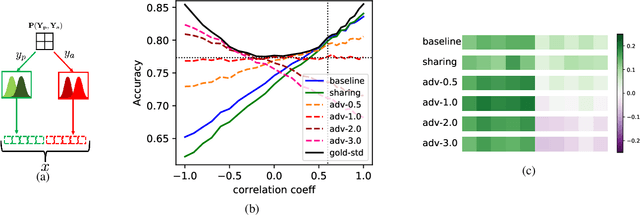
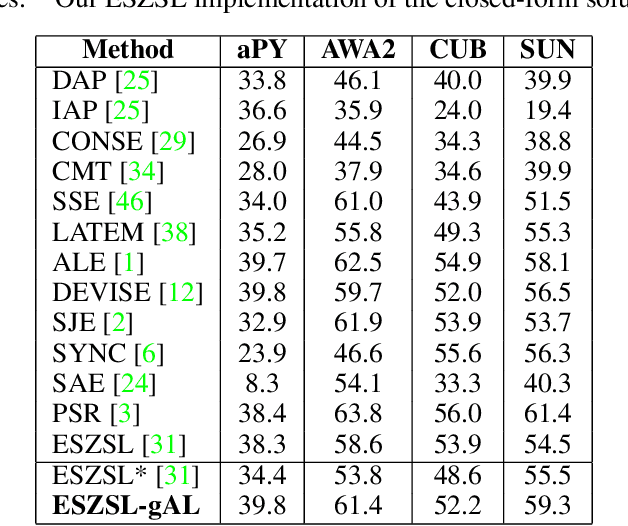
Abstract:In this paper, we present a new paradigm to zero-shot learning (ZSL) that is trained by utilizing additional information (such as attribute-class mapping) for specific set of unseen classes. We conjecture that such additional information about unseen classes is more readily available than unsupervised image sets. Further, on close examination of the underlying attribute predictors of popular ZSL algorithms, we find that they often leverage attribute correlations to make predictions. While attribute correlations that remain intact in the unseen classes (test) benefit the prediction of difficult attributes, change in correlations can have an adverse effect on ZSL performance. For example, detecting an attribute 'brown' may be the same as detecting 'fur' over an animals' image dataset captured in the tropics. However, such a model might fail on unseen images of Arctic animals. To address this effect, termed target-shift in ZSL, we utilize our proposed framework to design grouped adversarial learning. We introduce grouping of attributes to enable the model to continue to benefit from useful correlations, while restricting cross-group correlations that may be harmful for generalization. Our analysis shows that it is possible to not only constrain the model from leveraging unwanted correlations, but also adjust them to specific test setting using only the additional information (the already available attribute-class mapping). We show empirical results for zero-shot predictions on standard benchmark datasets, namely, aPY, AwA2, SUN and CUB datasets. We further introduce to the research community, a new experimental train-test split that maximizes target-shift to further study its effects.
A deep learning approach to solar-irradiance forecasting in sky-videos
Jan 15, 2019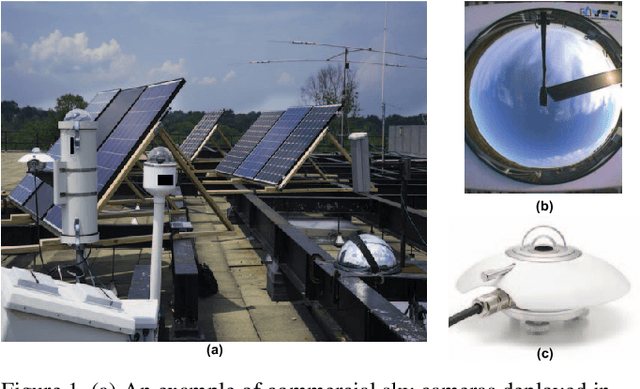

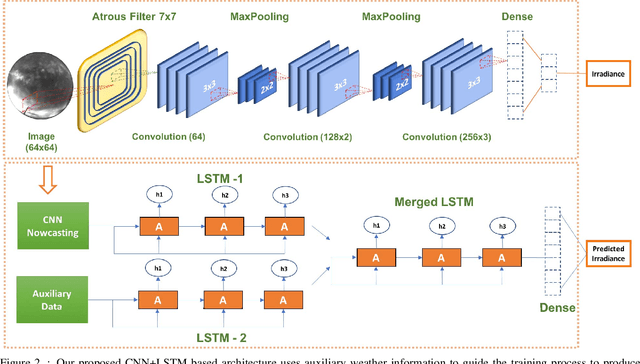

Abstract:Ahead-of-time forecasting of incident solar-irradiance on a panel is indicative of expected energy yield and is essential for efficient grid distribution and planning. Traditionally, these forecasts are based on meteorological physics models whose parameters are tuned by coarse-grained radiometric tiles sensed from geo-satellites. This research presents a novel application of deep neural network approach to observe and estimate short-term weather effects from videos. Specifically, we use time-lapsed videos (sky-videos) obtained from upward facing wide-lensed cameras (sky-cameras) to directly estimate and forecast solar irradiance. We introduce and present results on two large publicly available datasets obtained from weather stations in two regions of North America using relatively inexpensive optical hardware. These datasets contain over a million images that span for 1 and 12 years respectively, the largest such collection to our knowledge. Compared to satellite based approaches, the proposed deep learning approach significantly reduces the normalized mean-absolute-percentage error for both nowcasting, i.e. prediction of the solar irradiance at the instance the frame is captured, as well as forecasting, ahead-of-time irradiance prediction for a duration for upto 4 hours.
 Add to Chrome
Add to Chrome Add to Firefox
Add to Firefox Add to Edge
Add to Edge